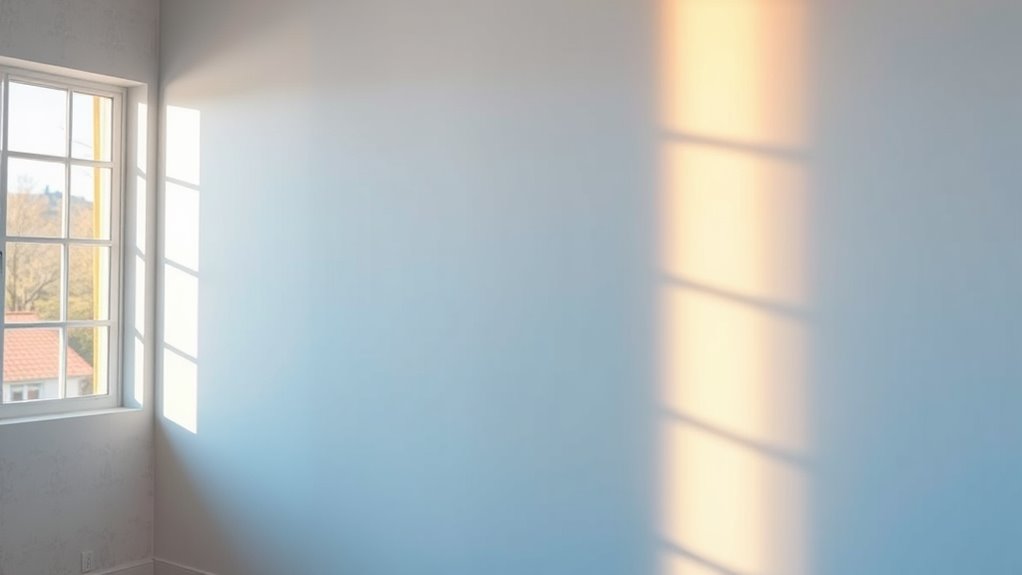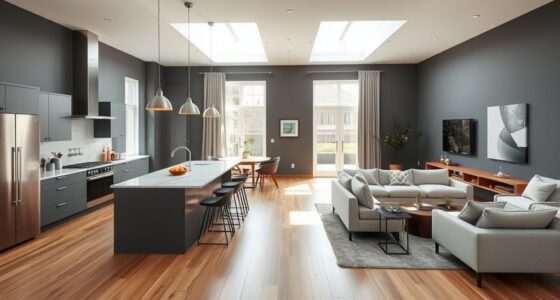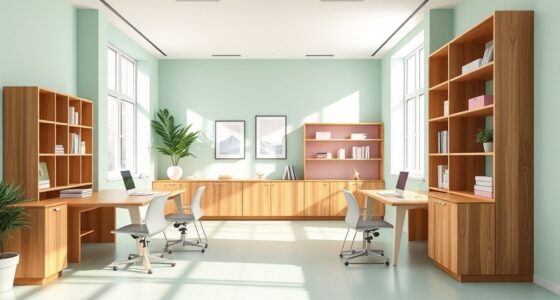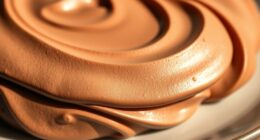Light temperature has a big impact on how you perceive your wall colors. Warm light (lower Kelvin) makes yellows and earthy tones appear richer and cozier, while cool light (higher Kelvin) enhances blues, greens, and neutral shades, giving a modern feel. Mixing different light temperatures can create complex color effects and mood shifts. Understanding how your lighting affects color perception helps you make better choices, and exploring more will reveal even smarter lighting tricks.
Key Takeaways
- Warm light (lower Kelvin) makes wall colors appear softer, yellow, or amber, enhancing coziness and depth.
- Cool light (higher Kelvin) intensifies blue and green tones, creating a modern, crisp ambiance.
- Changing light temperature shifts color perception, causing walls to look warmer or cooler than their actual hue.
- Different lighting conditions at various times of day can alter how wall colors are perceived.
- Testing wall colors under multiple light temperatures ensures accurate color perception in real-world settings.
The Science Behind Light Temperature and Color Perception

Understanding how light temperature influences color perception begins with recognizing that different types of light emit varying wavelengths and intensities. Color temperature, measured in Kelvin, determines whether light appears warm, neutral, or cool. This variation causes a perception shift in how you see wall colors. For example, warm light with lower Kelvin values makes colors appear softer and more yellow or amber, while cool light with higher Kelvin values enhances blue and green tones. When you change the light source’s temperature, it directly impacts how your eyes interpret wall hues, creating subtle or dramatic shifts in color perception. Recognizing the impact of light on perception helps you predict how a room’s ambiance will change under different lighting conditions, allowing you to choose lighting setups that best suit your desired aesthetic.
Warm Light: How Yellow and Amber Tones Transform Walls
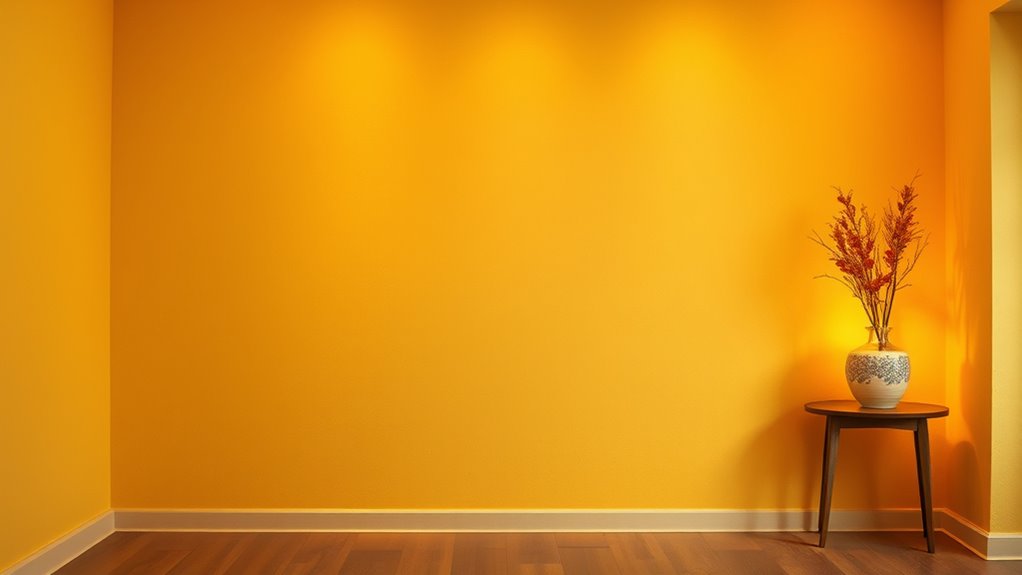
Warm light, like yellow and amber tones, can remarkably change how your walls look. It enhances warm colors, making them feel richer and more inviting. Plus, amber adds a cozy atmosphere, while yellow brightens spaces, making them feel more lively. Engaging in creative practice such as experimenting with different lighting can help you discover the most appealing ambiance for your space.
Warm Light Enhances Warm Tones
When you illuminate your walls with yellow or amber-toned light, the warm hues become more vibrant and inviting. This type of lighting enhances warm tones by creating striking lighting contrasts that make colors pop. Walls with rich textures, like stucco or textured paint, reflect the warm light differently, emphasizing their depth and intricacies. The subtle interplay between light and wall texture adds dimension, making warm colors appear even more cozy and welcoming. By choosing warm lighting, you amplify the natural richness of warm tones, turning simple walls into focal points of comfort. Additionally, this lighting approach can influence the perceived color accuracy, making warm hues appear more vivid and true to their tone. This effect works best in spaces where you want to foster intimacy and warmth, as the lighting accentuates the inviting qualities of warm colors while highlighting wall texture details.
Amber Adds Cozy Feel
Amber lighting creates an inviting atmosphere that makes your walls feel cozy and comforting. The warm hue of amber lighting enhances yellow and amber tones, adding a rich depth to your space. When you choose amber lighting, your walls take on a softer, more intimate appearance, perfect for creating a cozy ambiance. This warm glow subtly emphasizes warm-colored paint, making rooms feel welcoming and snug. Amber lighting also reduces harsh shadows, smoothing out imperfections and giving your walls a gentle, soothing look. If you’re aiming for a space that feels inviting and relaxed, incorporating amber lighting can transform your environment effortlessly. It’s an easy way to add warmth and intimacy, making your walls and overall space feel more comforting and inviting. Additionally, choosing the right color temperature can further enhance the desired cozy effect.
Yellow Brightens Walls
Yellow lighting, like amber, creates a bright and cheerful environment that can dramatically enhance your walls. When you choose yellow-toned lighting, the lighting effects can make your wall paint appear warmer and more inviting. This warm glow tends to brighten dull or muted colors, making them pop and feel more vibrant. If your walls are painted in light or neutral shades, yellow light can add a subtle warmth that transforms the space into a lively and welcoming area. It also helps to emphasize the texture and undertones of your wall paint, creating a cozy atmosphere. Keep in mind that the intensity of yellow lighting influences how your walls look, so adjusting the brightness can help you achieve the perfect balance for your desired ambiance. Additionally, understanding sound vibrations can deepen your appreciation of how light and color influence mood and perception.
Cool Light: The Impact of Blue and White Hues on Wall Colors
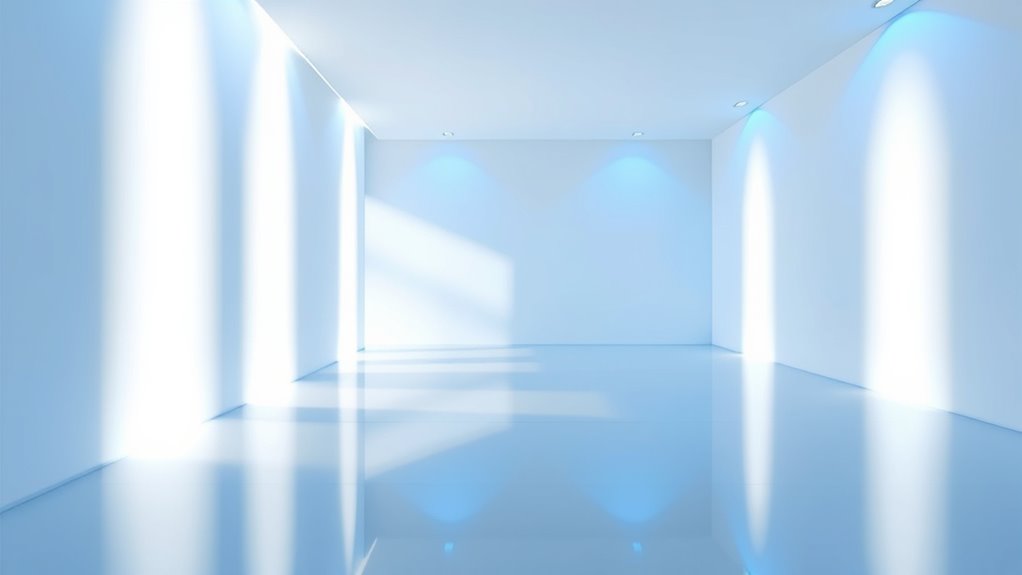
When you use cool light, blue hues make cool-toned walls appear more vibrant and invigorating. White light, on the other hand, amplifies the brightness of neutral shades, making spaces feel more open. Understanding these effects helps you choose the right lighting to enhance your wall colors effectively. Additionally, the light temperature can influence how your vehicle’s paint colors appear, similar to how wall hues are affected, by altering their perceived vibrancy and warmth.
Blue Light Enhances Cool Tones
Blue light intensifies cool tones in wall colors, making blues, greens, and other icy hues appear more vibrant and subdued. When you choose lighting fixtures with a higher color temperature, such as those emitting blue-rich light, your space will highlight these cool shades more prominently. This effect is especially noticeable in rooms with cool-toned paint, as the blue light enhances their natural chilliness. Keep in mind, the brightness and hue of your light source influence how strongly these colors pop. By selecting fixtures that emit a bluish hue, you can create a calming, modern atmosphere that emphasizes cooler shades. Additionally, understanding light color temperature helps you better tailor your lighting to achieve the desired ambiance. Overall, blue light’s impact on wall color depends heavily on your lighting choices, especially the color temperature of your fixtures.
White Light Brightens Neutrals
White light, especially those with a cool, bluish tint, can substantially brighten neutral wall colors, making shades like beige, gray, and taupe appear more crisp and vibrant. This effect enhances the appearance of various wall paint types and can transform a room’s ambiance. When selecting lighting fixtures, opt for LED or fluorescent lights that emit a bright, white hue to maximize this effect. The right lighting highlights the subtle undertones in neutrals, giving your walls a fresh, clean look. To visualize this, consider the following:
| Wall Paint Type | Effect Under White Light |
|---|---|
| Beige | Brightens and warms |
| Gray | Enhances crispness |
| Taupe | Adds vibrancy |
| White | Pure and luminous |
Additionally, understanding how self-watering plant pots work can inspire interior design choices that incorporate living elements, enhancing the overall brightness and freshness of a space.
The Effect of Mixed Lighting on Wall Color Appearance
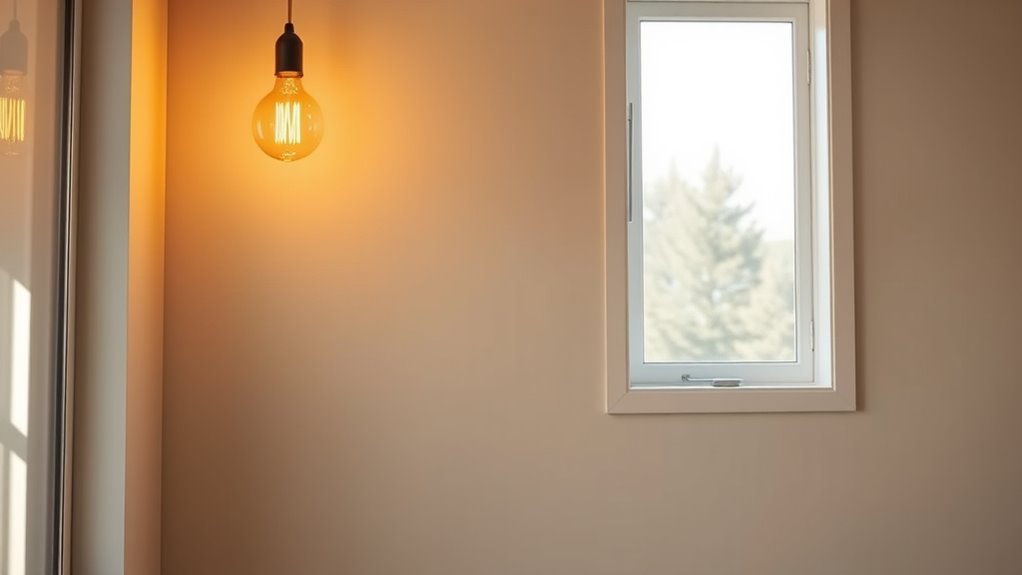
Mixed lighting conditions can dramatically alter how wall colors appear in your space. When different light sources with varying color temperatures shine together, it creates complex effects through color mixing and light layering. These combined lights can cause your walls to seem warmer or cooler than they actually are, depending on the dominant hue. For example, mixing warm incandescent light with cooler LED lighting may result in a neutral or shifting color perception. Light layering can also highlight certain tones or create subtle color shifts, making your walls look different at various times of day or under different lighting setups. Understanding how these factors influence perception helps you anticipate how your wall colors will look in mixed lighting, preventing surprises and ensuring your space feels just right. Recognizing that individual responses vary based on personality and environment is essential when planning your lighting design.
Choosing the Right Lighting for Different Wall Colors
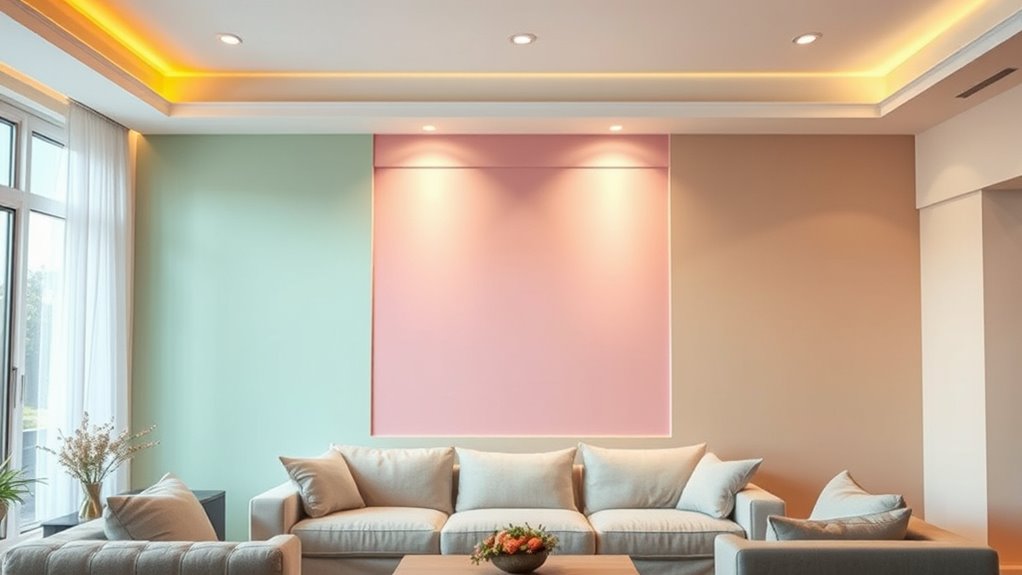
Choosing the right lighting is essential to showcase your wall colors effectively. The type of wall paint options you select can influence how lighting fixtures highlight or distort their true hues. Warm light enhances cozy, inviting tones, making beige or soft yellows appear richer. Cool lighting, on the other hand, accentuates crisp blues and grays, giving your space a modern feel. When choosing lighting fixtures, consider the color temperature that complements your wall paint options. For darker or more vibrant hues, use adjustable fixtures to control brightness and avoid overstating or dulling the colors. Proper lighting guarantees your wall colors look their best at all times, whether during daytime or evening, creating a balanced and harmonious atmosphere in your space. Additionally, understanding personality traits can help you create lighting schemes that align with your personal style and preferences.
Practical Tips for Testing Wall Colors Under Various Lighting Conditions
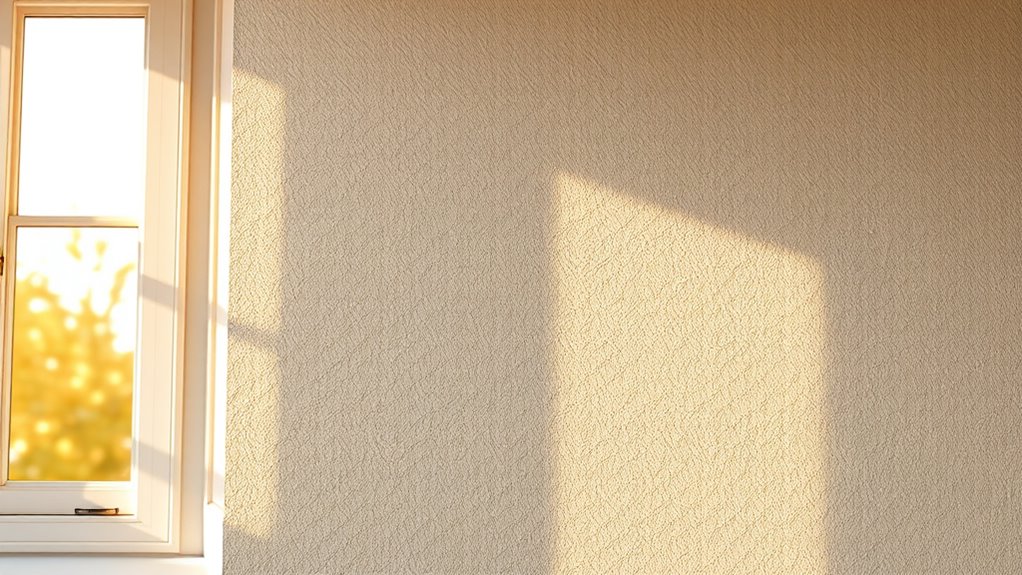
Testing your wall colors under different lighting conditions is essential to guarantee they look their best throughout the day. Start by examining your chosen paint under various light sources, such as natural daylight, incandescent, and LED lighting fixtures. Pay close attention to how different color temperatures affect the appearance of your walls; warmer lights emphasize yellow and red undertones, while cooler lights highlight blue and gray shades. To get accurate results, use sample patches on your walls and observe them at different times of day and under different fixtures. Adjust the lighting fixtures if needed, adding dimmers or swapping bulbs to see how the color responds. This process helps you select a wall color that consistently looks great, regardless of lighting conditions.
How Time of Day Influences the Look of Your Walls
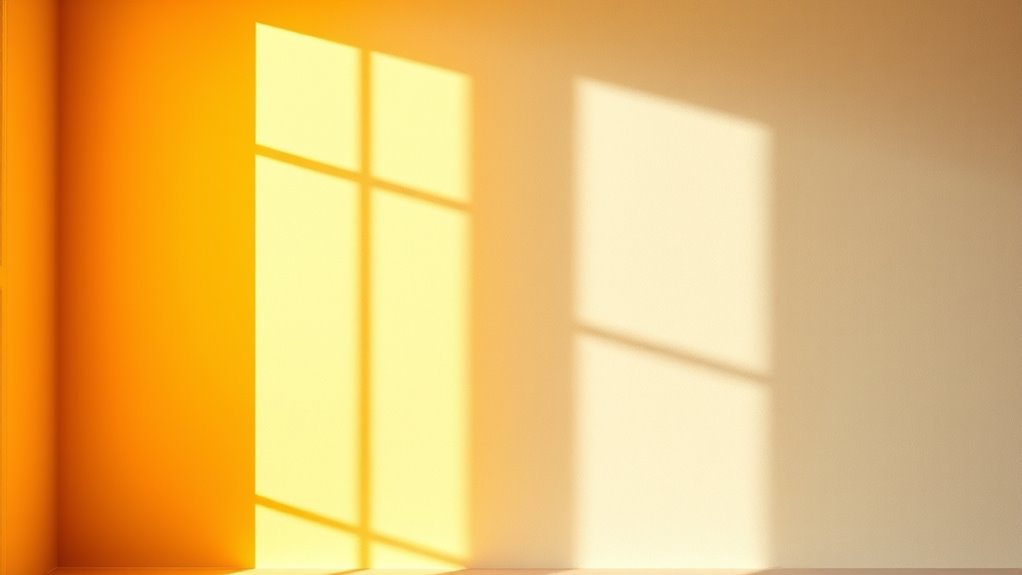
The way your wall colors appear can change considerably throughout the day due to natural sunlight variations. In the morning, soft natural sunlight can make warm tones seem more vibrant, while cooler tones may look subdued. As the day progresses, the intensity and angle of sunlight shift, altering how colors are perceived. During midday, bright natural sunlight can wash out some shades, making them appear lighter or more muted. In the evening, fading natural light combined with artificial lighting creates a different ambiance, often warmer and more subdued. Artificial lighting, whether warm or cool, also influences how your walls look at different times. Understanding this interplay helps you anticipate how your chosen colors will evolve throughout the day, ensuring they meet your expectations at all times.
The Role of Light Temperature in Interior Design and Mood Setting
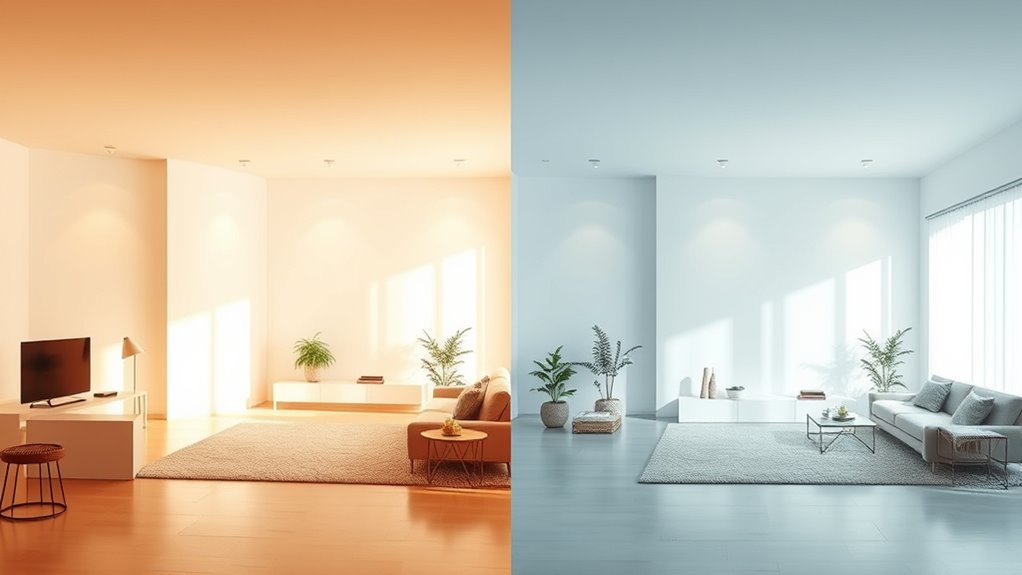
Light temperature plays a essential role in shaping the mood of your interior spaces, as it influences how colors and textures appear and how you feel within a room. Warm light creates a cozy, inviting atmosphere, perfect for relaxing or entertaining. Cool light, on the other hand, fosters a clean, energizing environment suitable for work or focus. By adjusting the light temperature, you can craft the right lighting ambiance to match your desired mood. Using mood lighting with warmer tones enhances intimacy and comfort, while cooler tones promote alertness and clarity. Understanding how different light temperatures affect your space helps you select the right lighting to support your interior design goals and evoke specific emotions. Ultimately, light temperature guides the atmosphere you experience daily.
Common Mistakes When Evaluating Wall Colors in Different Lighting Environments
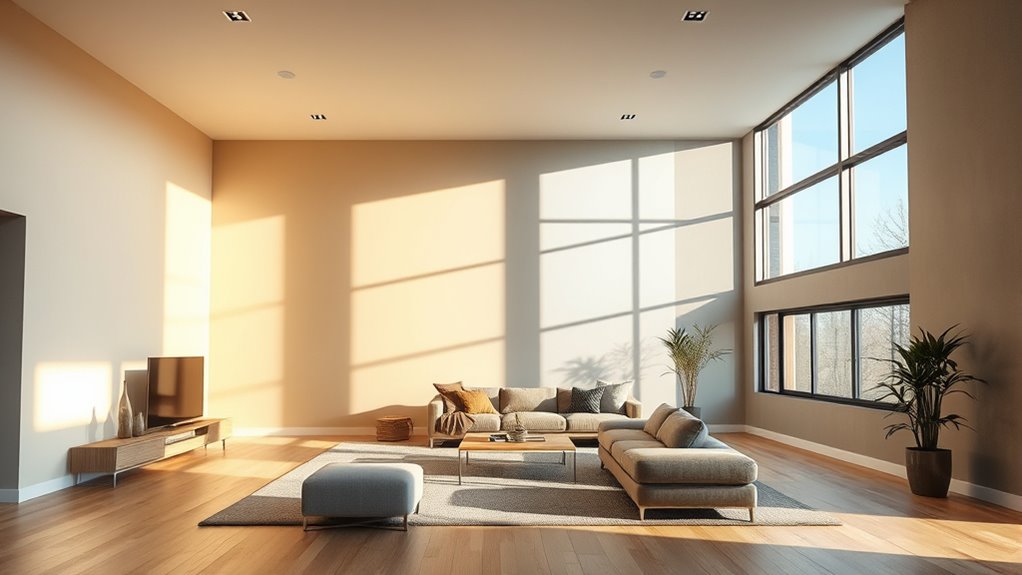
Evaluating wall colors without considering different lighting conditions can lead to misleading results and disappointing outcomes. One common mistake is overlooking the importance of lighting consistency; you might choose a paint based on how it looks in daylight but forget how it appears under artificial or warm light. This can cause mismatched expectations and color disappointment. Another mistake is rushing your paint selection without testing samples in the actual room lighting over several hours. Different light temperatures can drastically change how a color appears on your walls. Always test paint samples in the intended space and under various lighting conditions to see true color behavior. This approach ensures your chosen wall color remains appealing and consistent regardless of lighting changes.
Frequently Asked Questions
Can Light Temperature Change the Perceived Texture of Wall Paint?
Yes, light temperature can change how you perceive wall texture and paint sheen. Warm lighting tends to soften textures, making wall surfaces appear smoother and more inviting, while cool lighting highlights textures, revealing details you might not notice otherwise. The paint sheen also appears different under various light temperatures, affecting the overall look. So, when choosing lighting, consider how it influences your perception of wall texture and sheen to achieve your desired ambiance.
How Does Natural Versus Artificial Lighting Affect Wall Color Perception?
Ever notice how your wall color seems different inside versus outside? Natural lighting, with its warm or cool color temperature, highlights your paint sheen, making blues pop or yellows glow. Artificial lighting, often cooler or warmer, can dull or intensify those hues. You see, light temperature directly influences how you perceive wall color, so selecting the right lighting guarantees your space looks just right, whether it’s day or night.
Are There Specific Light Temperatures Best Suited for Certain Paint Finishes?
You should choose specific light temperatures that complement your paint finish to enhance your space. For matte finishes, warmer light temperatures, around 2700K to 3000K, create a cozy feel, while cooler temperatures, 4000K to 5000K, suit glossy or satin finishes, making colors pop. The right light temperature highlights your paint’s texture and tone, so consider your desired ambiance and paint finish to select the best lighting.
How Do Seasonal Changes Influence Wall Color Appearance Indoors?
You notice that seasonal daylight and artificial light influence your wall color appearance indoors. During winter, limited natural light makes colors look duller, while summer’s abundant sunlight enhances their vibrancy. Artificial lighting can also shift color perception, especially if it mimics daylight or warm tones. To keep your walls looking consistent year-round, consider using balanced lighting that complements seasonal changes and enhances your chosen paint color.
Can Adjustable Lighting Help Maintain Consistent Wall Color Perception?
Think of adjustable lighting as your wall’s best friend, guiding its true color through changing moods. With it, you can guarantee lighting consistency, so your walls look just as you want, regardless of time or season. By fine-tuning the light temperature, you help maintain accurate color perception, preventing unexpected shifts that can distort your space’s ambiance. It’s like having a steady hand on the canvas of your home’s appearance.
Conclusion
Understanding how light temperature influences wall color helps you make smarter choices in your space. While some believe natural light always shows true colors, studies suggest warm lighting can enhance cozy tones, and cool light may make colors appear sharper. By testing your walls under various lighting conditions, you can verify this theory yourself. Embrace the idea that lighting truly shapes perception—it’s not just a theory, but a proven tool for creating your ideal ambiance.
